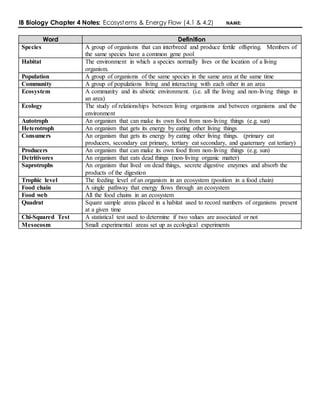
4.1 & 4.2 Notes
- 1. IB Biology Chapter 4 Notes: Ecosystems & Energy Flow (4.1 & 4.2) NAME: Word Definition Species A group of organisms that can interbreed and produce fertile offspring. Members of the same species have a common gene pool Habitat The environment in which a species normally lives or the location of a living organism. Population A group of organisms of the same species in the same area at the same time Community A group of populations living and interacting with each other in an area Ecosystem A community and its abiotic environment. (i.e. all the living and non-living things in an area) Ecology The study of relationships between living organisms and between organisms and the environment Autotroph An organism that can make its own food from non-living things (e.g. sun) Heterotroph An organism that gets its energy by eating other living things Consumers An organism that gets its energy by eating other living things. (primary eat producers, secondary eat primary, tertiary eat secondary, and quaternary eat tertiary) Producers An organism that can make its own food from non-living things (e.g. sun) Detritivores An organism that eats dead things (non-living organic matter) Saprotrophs An organism that lived on dead things, secrete digestive enzymes and absorb the products of the digestion Trophic level The feeding level of an organism in an ecosystem (position in a food chain) Food chain A single pathway that energy flows through an ecosystem Food web All the food chains in an ecosystem Quadrat Square sample areas placed in a habitat used to record numbers of organisms present at a given time Chi-Squared Test A statistical test used to determine if two values are associated or not Mesocosm Small experimental areas set up as ecological experiments
- 2. 4.1.1 Species are groups of organisms that can potentially interbreed to produce fertile offspring. 4.1.2 Members of a species may be reproductively isolated in separate populations. 4.1.3 Species have either an autotrophic or heterotrophic method of nutrition (a few species have both). 4.1.4 Consumers are heterotrophs that feed on living organisms by ingestion. 4.1.5 Detritivores are heterotrophs that obtain organic nutrients from detritus by internal digestion. 4.1.6 Saprotrophs are heterotrophs that obtain organic nutrients from dead organic matter by external digestion. 4.1.12 Classify species as autotrophs,consumers, detritivores, or saprotrophs from a knowledge of their mode of nutrition. 4.1.7 A community is formed by populations of different species living togetherand interacting with each other. What defines a species? What makes up a population? Define the following terms and give one example for each: Autotroph: Heterotroph: What is a Consumer and what does it mean to ingest food? Give one example. What is a Detritivore? Give one example. Give examples of dead organic matter, or detritus, that a detritivore might ingest: What is a Saprotroph? Give one example. Complete the diagram, below, filling in definitions/ descriptions: What makes up a community?
- 3. 4.1.13 Test for association between two species using a chi-squared test with data obtained from quadrat sampling. 4.1.14 Recognize and interpret statistical significance. Describe how ecologists use Quadrat sampling: Steps for a Chi-Squared test for association between two values: 1. 2. 3. 4. 5. 6. State the Null Hypothesis (H0): State the Alternative Hypothesis (H1): What of level significance (%) is usually used to determine if the means of two sets are statistically significant or different?
- 4. 4.1.8 A community forms an ecosystemby its interactions with the abiotic environment. 4.1.9 Autotrophs and heterotrophs obtain inorganic nutrients from the abiotic environment. 4.1.10 The supply of inorganic nutrients is maintained by nutrient cycling. 4.1.11 Ecosystems have the potential to be sustainable over long periods of time. 4.1.15 Setting up sealed mesocosms to try to establish sustainability. Define the term ‘Ecosystem:’ What are the major chemical elements that make the carbon compounds organisms use as food? Where do autotrophs obtain inorganic nutrients from in the environment? Where do heterotrophs obtain inorganic nutrients from in the environment? Describe how nutrients cycle through ecosystems: What does it mean for something to be sustainable? Outline the three requirements for sustainable ecosystems and howthey are maintained: Nutrient availability: Detoxification of waste products: Energy availability: What is a Mesocosm? Should the container for the Mesocosmbe transparent or opaque? Which groups of organisms should be included?
- 5. 4.2.1 Most ecosystems rely on a supply of energy from sunlight. 4.2.2 Light energy is converted to chemical energy in carbon compounds by photosynthesis. 4.2.3 Chemical energy in carbon compounds flows through food chains by means of feeding. 4.2.4 Energy released by respiration is used in living organisms and converted to heat. 4.2.5 Living organisms cannot convert heat to other forms of energy. 4.2.6 Heat is lost from ecosystems. 4.2.7 Energy losses between trophic levels restrict the length of food chains and the biomass of higher trophic levels. 4.2.8 Quantitative representations of energy flow using pyramids of energy. How is light energy converted into useable chemical energy and by which types of organisms? Label the trophic levels in the food chain, below: What do the arrows represent? Give examples of cell activities that use energy released by respiration: Describe the energy transformation in cell respiration: Outline ways that energy is lost (~90%) between trophic levels: Draw a trophic energy pyramid with three levels. Label trophic levels and energy amounts (including units)—follow the 10% rule and start with 10,000 kJ m-2yr-1:
